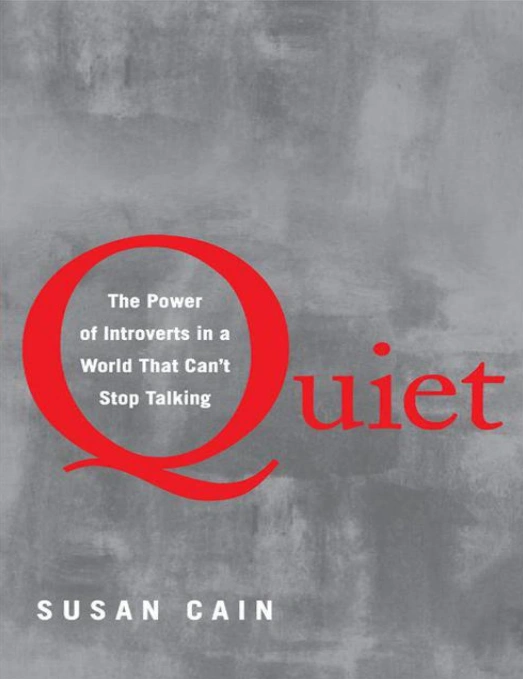
Quiet: The Power of Introverts challenges the myth that only extroverts can lead, innovate, or inspire. Susan Cain reveals how introverts bring depth, creativity, and empathy to the world. Through science, storytelling, and personal insight, she makes the case for honoring quiet voices in a noisy world. This book empowers introverts to embrace their strengths and helps everyone understand the power of stillness and thought.
Quiet: The Power of Introverts is a groundbreaking book that redefines how society views introversion and challenges the dominance of extroversion in modern culture.
Written by Susan Cain , a former corporate lawyer turned author and speaker, this book is the result of over seven years of research into the psychology of introverts. Drawing from neuroscience, history, and personal stories—including her own journey as an introvert—Cain makes a powerful case for the strengths of quiet personalities and argues that introverts bring essential value to workplaces, schools, relationships, and leadership.
She explores how Western society has created an “extroversion ideal”—a belief that the best leaders, students, and employees are outgoing, assertive, and talkative. But this bias often overlooks the deep thinking, creativity, and empathy that many introverts naturally possess.
Key Insight: Introversion is not a flaw or weakness—it’s a different way of being that deserves recognition and respect.
At the heart of the book is the distinction between introverts and extroverts , based on how they respond to stimulation—particularly social stimulation.
Cain explains that these differences are rooted in biology and brain chemistry—not just personality.
Important Lesson: Introverts and extroverts simply have different needs—and both should be honored.
Cain delves into scientific research showing that temperament is partly innate. Some people are born with a more reactive nervous system, making them more sensitive to noise, conflict, and change—traits commonly associated with introversion.
One fascinating study she discusses is the “high-reactive” child, who is more cautious and observant in new situations. These children often grow up to be thoughtful, creative adults—but are frequently misunderstood or pressured to “come out of their shell.”
Key Insight: Introverts aren’t shy—they’re wired differently.
This understanding helps readers see introversion as a strength rather than something to be fixed.
Cain traces how Western culture shifted from a “Culture of Character” in the 19th century—valuing integrity, duty, and inner virtue—to a “Culture of Personality” in the 20th century, where charm, charisma, and self-promotion became the gold standard.
This shift was fueled by industrialization, mass media, and the rise of salesmanship as a valued skill. Figures like Dale Carnegie and his book How to Win Friends and Influence People became cultural touchstones, promoting extroverted traits as the key to success.
Important Lesson: We’ve been taught to equate speaking up with being smart, but silence can be equally powerful.
One of the most compelling sections of the book focuses on education . Schools today are largely designed for extroverts, with open classrooms, constant group work, and rewards for participation.
But Cain argues that this setup disadvantages quiet, reflective students who need time alone to process and learn deeply.
She highlights the benefits of small-group learning and individualized instruction , which allow introverted students to thrive without pressure to perform socially.
Key Insight: The classroom should be a place for all temperaments—not just the loudest ones.
In the workplace, the extroversion ideal also dominates. Open-plan offices, brainstorming sessions, and team-based performance reviews are common, even though they often stifle creativity and productivity—especially among introverts.
Cain debunks the myth that the best leaders are charismatic speakers. Instead, she shows that some of the most effective leaders are quiet, deliberate thinkers who listen well, empower others, and lead through vision—not volume.
Important Lesson: Great leadership isn’t about charisma—it’s about clarity, consistency, and connection.
She cites examples like Abraham Lincoln , Rosa Parks , and Bill Gates —all introverts who changed the world through quiet determination.
The book also explores how introverts and extroverts navigate friendships, dating, and marriage . Cain offers practical advice for balancing different temperaments in relationships.
For example:
Understanding and respecting these differences can lead to stronger, more harmonious relationships.
Key Insight: Opposites attract—but only when they understand each other’s needs.
While advocating for societal change, Cain also gives practical tools for introverts to live authentically in a loud world:
Important Lesson: You don’t have to become an extrovert to succeed—you just need to play your game well.
Quiet is more than a book about personality types—it’s a call for a cultural shift. Cain encourages readers to embrace diversity in temperament, recognizing that both introverts and extroverts have unique gifts to offer.
By creating space for quiet voices, we unlock innovation, creativity, and deeper human connection.
As Cain writes:
“We live in a world that glorifies the alpha male, the life-of-the-party girl, the salesman who never stops talking. But there’s zero correlation between being the best talker and having the best ideas.”